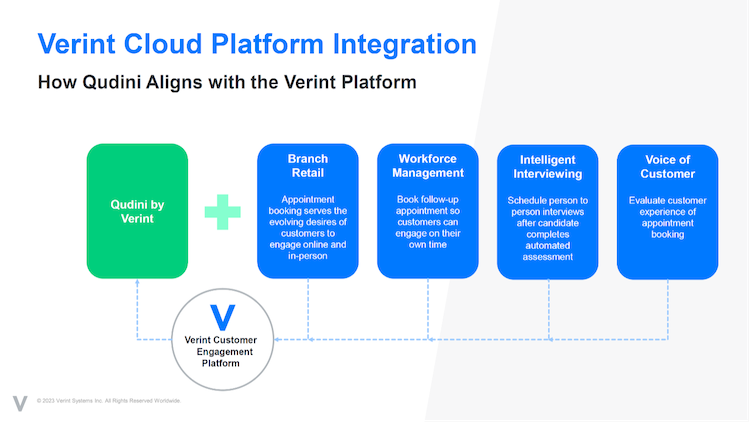Verint announced today that it has acquired Qudini, a provider of appointment scheduling solutions. Qudini is privately held and based in the U.K. The company has approximately 20 employees who will be joining Verint, including CEO Imogen Wethered. Terms of the acquisition were not disclosed.
As a leader in workforce engagement management, the acquisition of a scheduling company seems like a no-brainer. But Qudini describes itself as being in the business of retail choreography – a curious term of art that caused me to double-click on the purchase to learn more.
Qudini was established in 2012 after founders Wethered and Fraser Hardy attended the O2-sponsored Isobar Create London Hackathon. The two worked around the clock during the weekend hackathon to design and code an early prototype for their now award-winning Virtual Queuing System, a tool that eliminated the physical wait line in retail stores. The application won the competition and the team was accepted into Telefonica’s Wayra accelerator to build out the application and a commercial model.
Qudini’s original mission was to create omnichannel offerings so retailers could better manage and analyze their customer experience and business operations. Digitally transforming how customers scheduled appointments and services was the first thing Qudini tackled, with the goal of boosting brand and community interactions for stores and websites. This dovetails nicely with the Verint mission, “to help the world’s most iconic brands build enduring customer relationships by connecting work, data, and experiences across the enterprise.”
In a briefing with Trudy Cannon, director of go-to-market strategy, and Celia Fleischaker, CMO, both of Verint, Cannon explained how Qudini’s software will help some existing Verint customers replace sometimes-disconnected workarounds with a seamless solution to be delivered completely by the Verint Customer Engagement Management platform. The use case is around follow-up appointments: Qudini can be used to schedule time for customers to interact with an employee over the phone, via video chat, or face-to-face.
In a single interaction with an agent – or a mobile application – the customer can commit to an appointment time and day in a company location and the agent can ensure that the employee is also committed to that time, that it is on their schedule, and they don’t plan other customer engagements or activities in that time slot. Cannon went on to say that Verint customers could apply Qudini in both the contact center and for back-office and branch activities.
Fleischaker explained in the briefing that with the Qudini buy, Verint will be able to extend beyond voice and digital to support in-person engagements. The strategic roadmap for Qudini extends to:
- Booking person-to-person appointments with workforce management.
- Surveying customer engagement using location-based feedback.
- Serving the evolving desire to engage online and in-person with appointment booking and virtual queueing with branch retail customers.
Verint intends to work quickly to integrate Qudini’s appointment scheduling capabilities into the Verint platform. At the same time, Qudini will continue to sell its full portfolio to retailers and branch banks. Existing Qudini customers include Virgin Media/O2, broadcaster and telecommunications company Sky, and Specsavers, a British multinational optical retail chain with over 2,000 locations operating in the UK, Ireland, Australasia, and the Nordic countries.
There has been much discussion on No Jitter of the ways vendors can support hybrid work. With this acquisition, I believe that Verint is addressing a less-frequently discussed problem – how do we support hybrid customer engagement? Just as work life that has moved from the office to the home needs solutions to ensure this is done seamlessly, consumers have moved much of their retail behavior from in-person to remote and digital.











